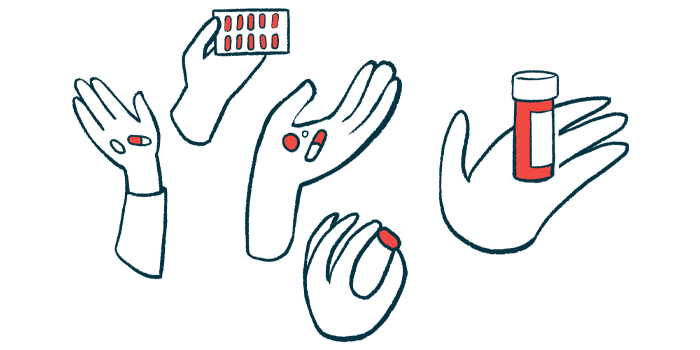Trikafta Helps Lung Function in CF Patients With Certain Mutations
Written by |

The triple-combination therapy Trikafta significantly improved lung function and life quality in a global Phase 3 trial that enrolled people with cystic fibrosis (CF) caused by one F508del mutation, and one gating mutation or one residual function mutation, in the CFTR gene.
Data from the trial were reported last year by Vertex Pharmaceuticals, which markets Trikafta. Now, the findings have undergone peer review and been published in the New England Journal of Medicine, in the study “Triple Therapy for Cystic Fibrosis Phe508del–Gating and –Residual Function Genotypes.”
CF is caused by mutations in the gene CFTR (cystic fibrosis transmembrane conductance regulator), which codes for a protein also called CFTR. Normally, the CFTR protein acts like a gate in a cell’s membrane, controlling the flow of salt and water in and out of the cell.
In CF, the CFTR protein doesn’t work properly; the exact problem depends on the type of CFTR mutation. Of particular note here are gating mutations — meaning the “gate” in the CFTR protein gets “stuck” closed — and residual function mutations, where not enough working CFTR protein gets to the cell’s surface.
The F508del mutation, which is the most common type of CF-causing mutation — is present in about 9 out of every 10 CF patients. This mutation causes the CFTR protein to fold incorrectly.
Trikafta is a combination of three CFTR modulators — elexacaftor, tezacaftor, and ivacaftor — a class of therapies that increase the functionality of the CFTR protein. Trikafta was first approved in the U.S. in 2019. That approval has since been expanded to include more mutations and patients as young as 6 years old.
In the new study, researchers at Vertex and other institutions reported data from a Phase 3 clinical trial (NCT04058353) that enrolled CF patients ages 12 and up who had one F508del mutation and either one gating mutation or one residual function mutation. Both of these groups are covered by the current U.S. approval.
The trial, sponsored by Vertex, was conducted at 96 sites in North America, Europe, and Australia. Participants first underwent a four-week run-in period of treatment with ivacaftor or tezacaftor/ivacaftor, two of the CFTR modulators in Trikafta.
Then, 126 participants — the controls — were randomized to continue on this same treatment for eight weeks. The remaining 132 participants were given Trikafta for the same period. Both groups were demographically similar: about half female, 90% white, and 3% Hispanic, with a mean age around 37 years.
The trial’s main measurement of efficacy was the change in percent predicted forced expiratory volume in one second (ppFEV1), a common assessment of lung function based on how much air a person can breathe out in a second.
After eight weeks, the mean ppFEV1 change in the control group was 0.2 percentage points. The mean change for those given Trikafta was significantly higher by 3.7 percentage points.
Additionally, in Trikafta-treated participants, average sweat chloride levels decreased significantly, by 22.3 millimoles per liter (mmol/L) after eight weeks. In the control group, the average sweat chloride level increased by 0.7 mmol/L.
Trikafta treatment led to an average increase of 10.3 points on the respiratory domain of the Cystic Fibrosis Questionnaire-Revised (CFQ-R), which was significantly higher than in the control group, where the score increased by 1.6 points.
“Consistent with the prior outcomes, these results show clinically meaningful improvements in pulmonary function, sweat chloride and [CFQ-R] respiratory domain scores,” Carmen Bozic, MD, executive vice president and chief medical officer at Vertex, said in a press release. “These results are especially notable given that all patients were treated with a CFTR modulator prior to initiating Trikafta.”
Further analyses showed that the between-group differences in ppFEV1 was higher among patients with gating mutations than with residual mutations (5.8 percentage points vs. 2 percentage points). This difference likely reflects differences in lung disease progression and age among the groups, according to the researchers — patients with residual mutations were older, on average (40.8 vs. 32.2 years).
About two-thirds of participants, in both treatment groups, experienced adverse events, most of which were mild or moderate in severity and consistent with Trikafta’s known safety profile.
Serious adverse events occurred in 3.8% of participants given Trikafta and in 8.7% of controls — the higher incidence among controls is because more controls experienced lung exacerbations, according to the scientists.
One participant on Trikafta discontinued treatment due to an adverse event, elevated levels of aminotransferase, a marker of liver damage.
“No new safety findings were noted as compared with previous studies. … These findings confirm the efficacy and safety of [Trikafta] in patients with at least one [F508del] allele,” the researchers concluded.








